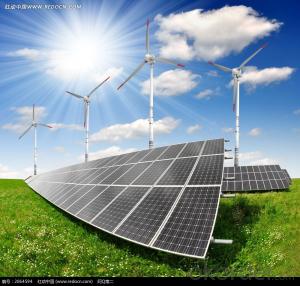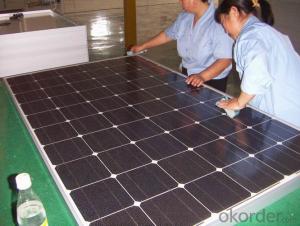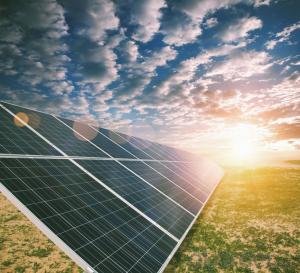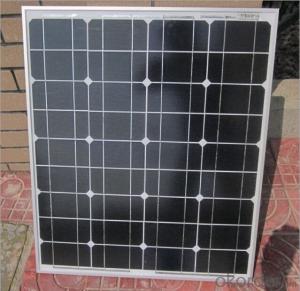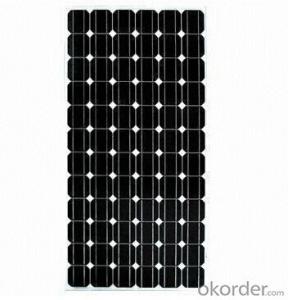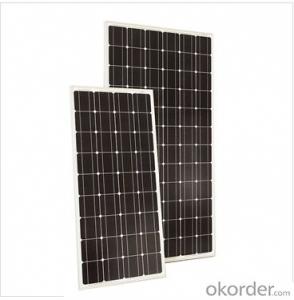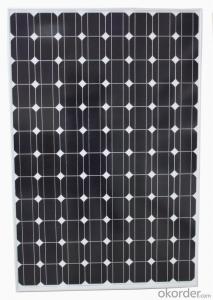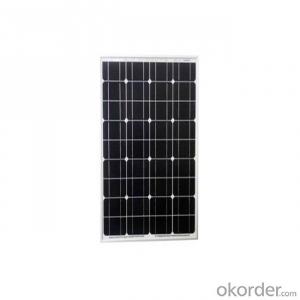Solar Panels Kissimmee FL - Monocrystalline Solar Panels 30W for Solar Systems
- Loading Port:
- Shanghai
- Payment Terms:
- TT or LC
- Min Order Qty:
- 10000 watt
- Supply Capability:
- 50000000 watt/month
OKorder Service Pledge
OKorder Financial Service
You Might Also Like
Product Description
Solar Monocrystalline Series Panels
Introduction of Monocrystalline Solar Panels
CNBM Solar photovoltaic (PV) Panel is designed for large electrical power requirements. It is the optimal choice for both on-grid and off-grid power systems. CNBM Solar panel offers high performance of power per square foot of solar array. Monocrystalline silicon(c-Si): often made using the Czochralski process. Single-crystal wafer cells tend to be expensive, and because they are cut from cylindrical ingots, do not completely cover a square solar cell module without a substantial waste of refined silicon. Hence most c-Si panels have uncovered gaps at the four corners of the cells.
Characteristics of Monocrystalline Solar Panels
I Solar Cell : High efficiency crystalline solar cell. Even if under the weak light, the solar module can produce maximum power output.
II Tempered glass (toughened glass): Anti-reflecting coating and high transmission rate glass increase the power output and mechanical strength of solar module.
III EVA and TPT: Using high quality EVA and TPT to prevent destroying and water.
IV AI frame: Without screw, corner connection. 6 holes on the frame can be installed easily.
V Junction box: Multi function junction box with water proof.
VI Long lifetime: ≥25 years; Less power decrease
VII Good performance of preventing from atrocious weather such as wind and hails.
VIII Resisting moisture and etching effectively, not effected by geology.
Standard Test Conditions of Monocrystalline Solar Panels
The opto-electrical specifications shown below are stabilized values being measured at Standard Test Conditions, Irradiance: 1000W/m2, Spectrum: AM1.5 at 25°C, The info below is subject to manufacturing tolerances. Where appropriate minutes of measurement are available and are used for the dimensioning of the installation.
Advantages of Monocrystalline Solar Panels
1.High reliability with guaranteed -3% to +5% power output tolerance, ensuring return on investment
2. High conversion efficiency based on leading innovative photovoltaic technologies
3. Withstands high wind-pressure and snow load, and extreme temperature variations
4. Attractive appearance Unique frame design, high mechanical strength, and easy Installation
Characteristics of Monocrystalline Solar Panels
Max Power Voltage Vmp (V) | 17.6V | 17.2 V |
Max Power Current Imp (A) | 1.71A | 2.33A |
Open Circuit Voltage Voc (V) | 22.6V | 22.2V |
Short Circuit Current Isc (A) | 1.83A | 2.48A |
Max Power Pm (W) | 30W | 40W |
Temperature Coefficient of Cells
NOCT | 47℃±2℃ |
Temperature Coefficients of Isc (%/℃) | 0.06 |
Temperature Coefficients of Voc (%/℃) | -0.33 |
Temperature Coefficients of Pmp (%/℃) | -0.45 |
Mechanical Data Solar Monocrystalline Series
Power | 90W/100W |
Dimension | 510×450×25mm/610×510×25mm |
Weight | 2.7 kg/ 3.7kg |
Tolerance | ±3% |
The dimension of the modules can be changed according to the demand of clients Limits.
Operating Temperature | –45 °C to +80°C |
Storage Temperature | –45 °C to +80°C |
Max System Voltage | 700V |
Guarantee Solar Monocrystalline Series Panels
Products Guarantee | 2 years free from defects in materials and workmanship |
Performance Guarantee | No less than 90% within 10yrs and no less than 80% within 25yrs |
Certificates | IEC, ISO, TUV, CE |
Dimension of Solar Monocrystalline Series Panels
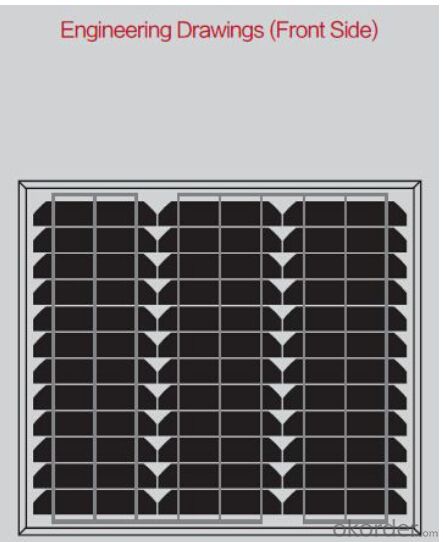

FAQ
We have organized several common questions for our clients,may help you sincerely:
1. What’s price per watt?
A: It’s depends on the quantity, delivery date and payment terms of the order. We can talk further about the detail price issue. Our products is high quality with lower price level.
2. Can you tell me the parameter of your solar panels?
We have different series of cells with different power output, both from c-si to a-si. Please take our specification sheet for your reference.
3. How do you pack your products?
We have rich experience on how to pack the panels to make sure the safety on shipment when it arrives at the destination.
4. What is your warranty system?
Our product performance guarantees for 25 years
• 12 years guarantee for workmanship
• Timeliness of delivery
• Quality Products certified (TÜV, UL, CE, ISO)
5. How do you pack your products?
We have rich experience on how to pack the panels to make sure the safety on shipment when it arrives at the destination.
It wasn't too long ago that the idea of generating electricity from the sun was a scifi dream, when it did become a reality it was mostly seen in small appliances, such as the humble desk top calculator. The sheer cost of solar panels for generating an alternative electricity supply for the home put the idea way beyond the reach of most home owners. But today, as solar cells are easier and cheaper to produce, solar panels are more popular. Of course, this interest is driven by a steady increase in the cost of National Grid power and a growing awareness of the damage traditional methods of power generation does to the environment.
Solar panels are created from multiple solar cells, the more energy we want to generate, the bigger the panel and the more cells we need. A solar cell is usually made from slices of silicon, the same as used in a CPU, which are mounted underneath a non reflective base, usually glass. Each solar cell generates a small current. However, if we link a sufficient number of these cells together we can increase the current proportionally. In this way we can increase the wattage to a level high enough to at least partially support an average household's electric usage, or even end their dependency on the local cable electricity supply.
So in short, when light strikes silicon it creates a small current, this current can be increased by linking many cells together in a panel. A solar panel. If you want more electricity, you simply add more panels.
There is a mathematical formulae for calculating the amount of watts generated so installers can easily estimate how many panels you want once they know your electricity consumption.
There are a couple of ways to have solar energy run your house, one is by installing ready made panels, bought from a hardware shop. You can have a trades person install them or do it yourself.
DIY is the second alternative to connecting your power needs to the sun, with a few tools a little knowledge of carpentry and common sense. You will need to buy solar cells, but after that you can build your own solar panels with very little effort.
- Q: Can solar panels be installed on camping sites?
- Yes, solar panels can be installed on camping sites. They provide a sustainable and reliable source of energy, allowing campers to power their devices and equipment while minimizing the environmental impact.
- Q: i have a calculator with a solar panel what could i power with it? like could i hook it up to a psp even though it will take forever to charge? and how would i do this?
- take a look at the back of the psp, most rechargeable things have technical specifications for what kind of charger to use, like the voltage, the amps, and the wiring
- Q: What is the principle of solar panels to convert solar energy into electricity?
- optical cable communication pump Station power, seawater desalination system, urban road signs, highway signs, etc. Europe and the United States and other advanced countries will be integrated into the photovoltaic power generation system and remote areas of natural village power supply system into the development of the combination of solar cells and building systems have been formed industry Trends
- Q: can this amount of solar charge these batteries.
- The solar panels are sufficient to charge the batteries. Your location is important as it relates to home many kWh/m2/day solar energy you receive. Check your actual solar power output using a current and volt meter, confirm you use at least a 3 stage battery charger. The total charged voltage should be about 2.7 volts. Check each cells voltage to see if one has failed.
- Q: Can solar panels be used on agricultural land?
- Yes, solar panels can be used on agricultural land. In fact, solar installations on farms and agricultural areas have become increasingly popular due to the dual benefits they offer. They not only generate clean energy but also provide farmers with an additional revenue stream. By utilizing solar panels on their land, farmers can offset their energy costs, reduce their carbon footprint, and contribute to a more sustainable future.
- Q: Can it be used on a cellphone so u never have to worry about low battery?
- Solar panels (arrays of photvoltaic cells) use renewable energy from the sun, and are a clean and environmentally sound means of collecting solar energy. Solar panels are a great way to generate electricity on a small scale. Solar panels are commonly named solar cells or photovoltaic cells. Photovoltaic means literally light electricity.” Solar cells or PV cells rely on the photovoltaic effect to absorb the energy of the sun and cause current to flow between two oppositely charged layers. Solar panel installation is a cost effective part of the green movement for saving energy. There are different types of solar panels available, including Monocrystalline Panels, Polycrystalline Panel, Cast Polycrystalline Panels, String Ribbon Silicone Panels and Thin Film Panels. Find more information about solar panels at this Web site:
- Q: ok so when a solar panel is marked as a certain wattage dose that mean it makes that much in a day in an hour or constant, dose it still work at night or what ? is it worth it or is it more of a pain? can some one tell me what all the watts and volts mean ?? and can some one tell me what a kilowhat is in refrence to some thing i understand like howmany loads of laundey can you do wt a watt? i need help understanding this stuff?
- Caykay, Your question is amazingly great and obscure so that's perplexing to respond to. photograph voltaic panels are designed to value DC batteries, so which you will would desire to alter your electric powered gadget to paintings with DC. So, your quesiton isn't that straightforward to respond to. you will desire to start on your very own examine to get to a useable prognosis / answer. you will desire to renowned what a watt is and an amp is. you will desire to renowned what the cost of a kilowatt is to confirm what proportion watts you utilize in a 300 and sixty 5 days. then you certainly can start to estimate what proportion photograph voltaic panels you want. you do no longer throw away photograph voltaic panels. this is the component of them. as quickly as bought, the capability supplied for years is considered 'loose'. the place you reside has alot to do with it too. Sunny Arizona, or Florida are great and could require fewer panels than different, extra cloudy places. expenditures and structures are complicated, yet obtainable to be researched on the information superhighway. you could touch broking / distributors and that they're going to clarify it ot you. superb to you.
- Q: Can solar panels be installed on a shaded area?
- Solar panels can still be installed in shaded areas, but they may not be as effective in generating electricity compared to panels installed in direct sunlight. The amount of shade and duration of shading throughout the day will impact the overall energy output of the solar panels.
- Q: Can solar panels be installed on a multi-story building?
- Yes, solar panels can be installed on a multi-story building.
- Q: Is it possible for the everyday person to increase the efficiency of solar panels that they own? If so, how is it done?
- There are 3 (simple) ways to increase the efficiency of a solar panel at home - they all work by increasing the amount of light that falls onto it: . Have the solar panel track the sun throughout the day so that it always faces it; 2. Place a lens (larger than the panel) in front of the panel that focuses the light from the sun onto it. 3. Have mirrors around the panel than redirect light from themselves onto the solar panel. (e.g. imagine a satellite dish with the solar panel at the front and the dish being all mirrored.)
Send your message to us
Solar Panels Kissimmee FL - Monocrystalline Solar Panels 30W for Solar Systems
- Loading Port:
- Shanghai
- Payment Terms:
- TT or LC
- Min Order Qty:
- 10000 watt
- Supply Capability:
- 50000000 watt/month
OKorder Service Pledge
OKorder Financial Service
Similar products
Hot products
Hot Searches
Related keywords












